by John Threlfall | Nov 12, 2015 | Alumni, Events, School of Music, Undergraduate
It’s an eternal story: boy meets girl, they fall in love—but, since the year is 1914, the boy must go off to war and their love must face an uncertain future.
The School of Music is pleased to welcome Pacific Opera Victoria for a special free production of Mary’s Wedding, a notable new Canadian opera about the impact of the First World War on the homefront. Described as “a love letter to the power of memory and innocence, and to a generation of Canadians who were caught in the crucible of the First World War,” Mary’s Wedding is an apt way to mark Remembrance Day on campus.
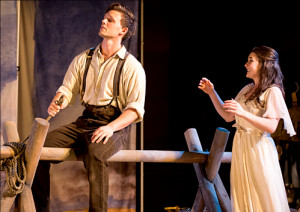
Kaden Forsberg & Caitlin Wood in a scene from Mary’s Wedding
Originally written for the stage by Stephen Massicotte and later developed into a full-scale English-language opera featuring music by Andrew P. MacDonald and Massicotte’s own libretto, POV has now created a re-imagined one-hour version of Mary’s Wedding that they will be presenting at 7:30pm Friday, November, 13, in the Phillip T Young Auditorium.
Set in Western Canada in the aftermath of World War I, Mary’s Wedding was originally commissioned by Pacific Opera Victoria and had its world premiere in November 2011. This production—directed by Art History & Visual Studies alumna Glynis Leyshon—features a strong School of Music presence, with first-year Masters candidate Kaden Forsberg in the lead role as Charlie, as well as third-year undergrad soprano Margaret Lingas in the chorus; joining her in the chorus is also Music tenor alumnus Cedric Spry. “The chorus is only a quartet, so it’s nice that two of our students are there,” notes proud Opera and Voice professor Benjamin Butterfield.
Mary’s Wedding explores the fleeting nature of time and the lasting power of love, evoking prairie thunderstorms and ladies’ teas, and, as innocence rides off to war, the horror of the battles of Ypres and Moreuil Wood, in which Canada came of age as a nation. Much of the production’s power comes from its sense of the fluidity of time, the shifting of past and present, here and there, reality and dream. The emotional impact is stunning: everything becomes present for us here and now . . . we are the children of Mary’s Wedding.
Seating is limited, so do arrive early.
by John Threlfall | Nov 5, 2015 | Alumni, Graduate, indigenous, Visual Arts
Having just completed two consecutive years as the University of Victoria’s Audain Professor of Contemporary Arts of the Pacific Northwest, Jackson 2Bears doesn’t hesitate to identify what he felt was the best part of the position in the Department of Visual Arts.
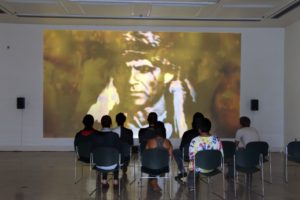
2Bears’ 2014 Audain exhibit, “Iron Tomahawks”
“Interacting with students and engaging with their research and creative practice has truly been the highlight of my two terms,” he says. “I have always aspired to encourage students to draw from their own life experiences as a source for exploring new creative possibilities.”
Two years in the position allowed 2Bears the space to develop both his teaching methodology and creative practice—a luxury not enjoyed by previous Audain professors Rebecca Belmore, Michael Nicol Yahgulanaas and Nicholas Galanin, who served one term each.
“Over the past years I have had time to really think about the importance of space, land and territory—as well as my place in the world as a Kanienkehaka [Mohawk] person, and the spaces I occupy as Onkwehonwe [an Indigenous person],” he says. “My meditations on ‘place’ have given me even more respect, and made me more appreciative of having been a visitor and a guest on Lekwungen territory during my Audain residency.”
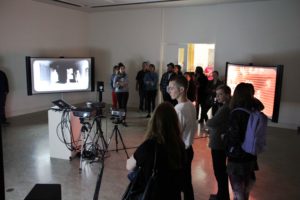
Students engage with 2Bears’ “For This Land”
One concrete result was For this Land, the first of a series of installation/performance artworks focusing on place and community. A collaborative project with Mohawk poet Janet Rogers, For this Land debuted at UVic’s Audain Gallery in September 2015; it was jointly inspired by Sioux philosopher Vine Deloria Jr.’s 1998 book of the same name and Chiefswood, Mohawk poet Pauline Johnson’s childhood home on the Six Nations Reserve.
“Both my research and creative/artistic practice have led me back to Haudenosaunee territory, and back to Six Nations,” says 2Bears. “For several days Janet and I spent time on our home territory, exploring the heritage site and creatively engaging with the stories that Pauline left for us on the land. We documented elements of this—our actions, experiences and conversations—and created an aesthetic interpretation of our dialogues with this place, and in turn, the stories we wrote on the land.”
He also feels his creative focus has shifted due to his experience as Audain Professor. “I’ve come to realize that right now, the ‘work’ I need to do—not just as an artist, but as an individual—has everything to do with (re)connecting with my home, my community, my language, culture, people and land.”
Building on his time as UVic’s Audain Professor, 2Bears is now Professor of Native American Art Studio and Canada Research Chair at the University of Lethbridge. The Audain Professorship was instrumental in his being able to make the transition from PhD student to faculty member. “I look forward to sharing stories and times with all my new relations,” he concludes.
by John Threlfall | Nov 5, 2015 | Events, Faculty, Research, Theatre
For a song written only days before the premiere, “Mack the Knife” has not only become the most recognized number from The Threepenny Opera, but also a musical standard performed by some of world’s greatest artists. The history of the song also represents a fascinating journey for how we view one of theatre’s most notorious villains, the character MacHeath—better known as Mack the Knife.

The beggars, prostitutes and down-and-out sing in Phoenix Theatre’s production of The Threepenny Opera (photo: David Lowes)
Bertolt Brecht’s The Threepenny Opera is a landmark of modern theatre. After opening in 1928 in Berlin, it became one of the biggest hits of the 1920s. Here was a satire so irreverent and cutting in its humour, so gritty in its reflection of the down-and-out, and so uncompromising in its criticisms of post-WWI German society that it would influence all theatre thereafter. Kurt Weill’s precedent-setting, jazz-influenced music would create a resurgence in the musical worldwide.
Opening November 5 at UVic’s Phoenix Theatre, this mainstage production of The Threepenny Opera is directed by Department of Theatre professor Brian Richmond who has set it in an absurd, near-future dystopia. Part biting satire and part sheer theatrical innovation, this famed musical is a landmark of modern theatre. “This is quite possibly the most important piece of musical theatre in the 20th century,” says Richmond, who worked with Applied Theatre professor Kirsten Sadeghi-Yekta to bring a strong sense of realism to this production.
To learn more about the vision behind this production, director Richmond will be giving a pre-show lecture at 7pm on Friday, November 6. The Threepenny Opera then runs 8pm Tuesday to Saturday to Nov 21 at UVic’s Phoenix Theatre, with a 2pm matinee on Saturday, November 21. Tickets range from $15 to $25 and can be charged by phone at 250-721-8000.

The ensemble cast of Phoenix Theatre’s The Threepenny Opera (photo: David Lowes)
The Threepenny Opera borrows from the 18th-century The Beggar’s Opera and offers an edgy mix of biting satire and sheer theatrical innovation as it takes aim at the traditional bourgeoisie and reveals a society where law is fickle, money corrupts and crime absolutely pays. Richmond is well-known for breathing fresh life into classic works, as evidenced by past Phoenix productions like Guys & Dolls, Dark of the Moon, The Wind in the Willows and Romeo & Juliet.
“Mack the Knife,” the song that has since become an iconic symbol of the play, was only added at the last minute at the behest of Harald Paulsen—the actor playing MacHeath in the premiere—as he wanted a number that would better introduce his character. A number of translations and versions of the play were produced following the original, but it wasn’t until Marc Blitzstein’s 1954 New York City version that Threepenny became a hit in America, ensconcing the play and its music in popular culture. Conducted by the preeminent Leonard Bernstein (a friend of Blitzstein) and featuring Lotte Lenya (Kurt Weil’s widow, who had been part of the original Berlin cast), it ran Off-Broadway for over six years and broke records set by Oklahoma.

Mack the Knife (Lindsay Robinson) flees from Polly (Pascal Lamothe-Kipnes) in Phoenix’s The Threepenny Opera (photo: David Lowes)
It was Blitzstein’s translation of “Mack the Knife” that was famously recorded by some of the biggest stars in the 1950s and ’60s, including Louis Armstrong, Bobby Darin, Ella Fitzgerald, Duke Ellington and Frank Sinatra. While based on the Blitzstein version, each artist made the song his or her own, accentuating or repeating different lyrics to highlight Mackie’s exploitive playboy nature. Musically, some interpreted the song with more swing, more jazz, more up-tempo, more lounge, as best fit the artist’s style. Armstrong spontaneously added Lotte Lenya’s name into the lyrics as she watched his recording session. Sinatra added references to many previous singers in his lyrics.
In 1976, a new version of Threepenny opened on Broadway (later made into a movie), featuring a version of “Mack the Knife” that returned to Brecht and Weill’s original idea of a murder song that accentuated MacHeath’s trail of victims more than his womanizing ways. This version was recorded in the ’80s and ’90s by the likes of Lyle Lovett, Sting and Nick Cave. Then, in 1994, Robert David MacDonald and Jeremy Sams hoped to recapture some of the original edginess of Brecht’s irreverent cutting humour and mounted a version of Threepenny with an emphasis on Mackie’s more gruesome villainous ways.
It is this most recent translation that director Richmond chose for the Phoenix production. “Directors often ask not only how, but why an audience responded to a particular work at the time of its premiere,” he says. “[We] then try to build an interpretive bridge between this central nerve, or zeitgeist, of the culture from which the work arose and the times in which we live now.”
Still reeling in the aftermath of the war, the 1920s German Weimar government was plagued with hyperinflation, political extremists, severe poverty and famine. At the same time, there was false sense of affluence and indulgence among the elite, leaving Germany teetering on the brink of inevitable disaster. As young artists and political activists, no doubt Brecht, Weill and friends could see that this house of cards was about to fall.

Director Brian Richmond
Director Brian RichmondThe 1994 translation restores the grittiness and angst of the original for today’s audiences. “Looking at the present day conditions—economic, political and social—it’s not difficult for current audiences to relate to this fear of an impending collapse of society,” says Richmond. “Thankfully this has not happened yet . . . which is why we decided to set this production in the future, where we can take for granted that society has already collapsed. We felt that an absurd dystopian future would further highlight the absurdity of how man’s appetite for greed, lust and gluttony, keeps contributing to our downfall.”
—Adrienne Holierhoek
The Threepenny Opera runs 8pm Tuesday to Saturday to Nov 21 at UVic’s Phoenix Theatre, with a 2pm matinee on Saturday, November 21. Tickets range from $15 to $25 and can be charged by phone at 250-721-8000.
by John Threlfall | Nov 3, 2015 | Events, Research, School of Music
During the Third Reich, two generations of composers and performers of Classical music were silenced, and with them, an important musical heritage. Many works by these composers are of truly exceptional quality but are rarely performed to this day.
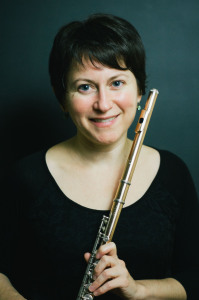
Suzanne Snizek
But School of Music professor and flutist Dr. Suzanne Snizek has dedicated much of her research and performance practice to music suppressed by Nazi Germany and will bring a program of works by Czech composers to the UVic stage on Thursday, November 5.
“Suppressed music is a term that could mean many things,” Snizek explains in an interview with the University of Alberta’s Curious Arts blog. “The usual ‘classical’ meaning of this term within musicological circles concerns music that was suppressed by the Third Reich. Often this music was suppressed simply because it was written by Jewish composers. Sometimes music might be suppressed for other ideological reasons—for example, the music was written by someone involved in leftist politics—or for aesthetic reasons—the regime was not fond of the avant grade generally.”
Snizek’s November 5 concert, accompanied by pianist Alexandria Le, will include works by suppressed composers Bohuslav Martinu, E. F. Burian, Jindrich Feld and Petr Eben.
Eben was a child survivor of the Holocaust; as an adult, he was further persecuted by the Communist regime of his native Czechoslovakia because he was a life long devout Catholic. Snizek will perform Eben’s Miniatures, which she describes as “a set of extraordinarily succinct and colourful character pieces.” Bohuslav Martinu, whose works are regarded as part of the Suppressed Music repertoire as well, fled the Nazi invasion of France by immigrating to the US in the 1940’s. His music has a strong folk quality to it and, in Snizek’s opinion, is always rhythmically satisfying to perform.
“Of course when we talk about suppression, we are also referring to more violent and sinister approaches, including deportation to concentration camps and murder,” notes Snizek. “A wide variety of incredibly talented composers from many countries were killed, including Erwin Schulhoff, Leo Smit, Pavel Haas, Gideon Klein, Victor Uhlmann and Hans Krasa. The loss to musical life on an international scale was enormous. The extent and depth of cultural damage is still striking to me after many years of studying this era.”
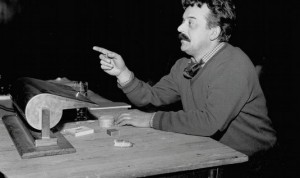
Suppressed composer EF Burian
On the other end of the political spectrum is composer E. F. Burian, a political insider who was very active as an artist during the Communist regime in Czechoslovakia. His music has often been avoided as a result of his political engagement during that era.
“I have never seen his work here in North America,” says Snizek, who picked up his Lost Serenade while she was in Prague in 1993, shortly after the fall of Communism. She describes the Burian as a “very sparse and technically simple” piece, making it a nice counterpart to the intricate Jindrich Feld Sonata on the program “which has all the notes—and more—that the Burian does not use!”
Music by Czech Composers is at 8pm Thursday, November 5, in UVic’s Phillip T. Young Recital Hall. Tickets are $14-$18.
—Kristy Farkas
by John Threlfall | Oct 29, 2015 | Award, Faculty, Research, Visual Arts
It’s shaping up to be quite the year for Department of Visual Arts professor Sandra Meigs. Hot on the heels of being named one of eight recipients of the Governor General’s Awards for Visual and Media Arts in March 2015—an honour that saw her work featured in a special curated exhibit at the National Gallery of Canada this past summer—she has also just closed All to All, her most recent solo exhibit of new work, at Toronto’s acclaimed Susan Hobbs Gallery. And now, Sandra Meigs has been announced as the winner of the $50,000 Gershon Iskowitz Prize at the AGO for 2015.

Meigs (photo: Michelle Alger)
“When I got the call about the prize I was at a rest stop on the 401 on my way to London, where I was going to do grad visits at Western,” Meigs explains from Ontario. “I’m told I said ‘I can’t believe it’ four times. The news just seemed to have dropped out of the sky as some sort of magical gift and settle into my GPS as the next stop on my way.”
In addition to the cash award, the Gershon Iskowitz Prize comes with a solo show at the Art Gallery of Ontario and a further $10,000 towards a publication on Meigs’ work.
“The Gershon Iskowitz Prize recognizes artists who have made a significant contribution to the field of visual arts in Canada,” notes Dr. Susan Lewis, Acting Dean of the Faculty of Fine Arts. “The Faculty congratulates renowned painter Sandra Meigs on this latest career achievement. Her creative body of work has a tremendous impact and influence on the contemporary visual arts scene. Her art informs her teaching and mentorship of students in our Faculty. The Fine Arts student experience is distinguished by the expertise and commitment that she brings to fostering a dynamic learning environment here at UVic.”
Describing winning the award as “a career highlight,” Meigs says the timing for it is ideal. “It couldn’t come at a better time for me since All to All took me two years to complete. And I am now ready and fresh to start something anew.”

“All to All”, the latest solo exhibit by Sandra Meigs
News of Meigs’ prize win was picked up by the Globe and Mail, CBC News, Canadian Art magazine, the Times Colonist and CBC Radio’s All Points West.
Meigs—currently on a semester of study leave—joins the celebrated ranks of past Gershon Iskowitz Prize winners like Jack Shadbolt, Gathie Calk, Shary Boyle, Michael Snow and Kim Adams.
Adding to the surprise of the announcement is the fact that artists do not apply for this prize. “I was blown away,” she admits with a laugh. “There was no nomination process—the decision was made by a curator, two Iskowitz Foundation trustees, and an artist from the Canadian arts community who agreed unanimously on their choice. The prize is given in recognition of, but also to further, an artist’s career—particularly an artist who is at a crucial turning point in advancing his or her work.”
The jury consisted of curator Lesley Johnstone, art collector Jay Smith, curator/critic Sarah Milroy and former Visual Arts student and 2014 Governor General’s Award winner Kim Adams. In a statement, Johnstone described Meigs’ work as “comical and sad, materially rich and socially engaged, psychologically intense but also somehow playful, her work continues to surprise us with each new project. Hers is a unique voice and her influence within the Canadian art milieu is strongly felt.”
For her part, Meigs is relieved the solo AGO exhibit won’t be mounted until 2017, given her recent focus on All to All, which she describes as “a very intense and joyful work.”

Watch this video of Sandra Meigs’ latest solo exhibit, All to All
“I’ll have two years to develop the new work for the AGO exhibition and I’m not sure right now what I will make,” she admits. “I know I’ll be keen to start as soon as I get back home. And having the AGO as a venue will also give the work a huge boost, not only because it will afford it a large space to show in—for which I have been yearning for some time—but also because my ‘fan base’ is in Toronto so I can not only show to them, but also reach out to a huge audience of AGO gallery viewers who might otherwise not get to know my work.”
Sandra Meigs’ work has been described as expressive, eclectic and interdisciplinary; her paintings are known for their unique approach in combining complex narratives with comic elements in large scale works such as The Basement Panoramas and Strange Loop. She is dedicated to painting and refers to the possibilities of enchantment that painting presents through colour and form. For Meigs, the very authenticity of one’s experience offers proof that what is imagined when looking at a painting is as real as anything else that one experiences in the world. In addition to painting, she has also woven sculpture, film, sound, and other media in her works.
As for the prize money, Meigs says she’ll use it to fund the pieces for the AGO exhibit. “New work always ends up costing a lot to produce, whether it’s research travel, studio costs, production materials, or for services one needs at various stages of the production.”
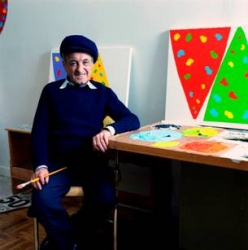
Prize creator & Canadian painter Gershon Iskowitz
Meigs also has high praise for the prize originator himself. “Canadian painter Gershon Iskowitz had the foresight to create this prize and the AGO to oversee its mandate,” she says. “Perhaps I will someday be able to leave such a legacy. I follow in the footsteps of so many great artists who have received this prize and I am extremely grateful.”
The Gershon Iskowitz Foundation joined with the AGO in 2007 to raise awareness of the visual arts in Canada. Canadian painter Gershon Iskowitz (1921-1988) recognized the importance of grants to the development of artists and acknowledged that a grant from the Canada Council in 1967 enabled him to formalize his distinctive style. The AGO is home to the artist’s archives, which include early works on paper, sketchbooks and ephemera, and holds 29 paintings by Iskowitz, spanning from 1948 to 1987, in its permanent collection.













